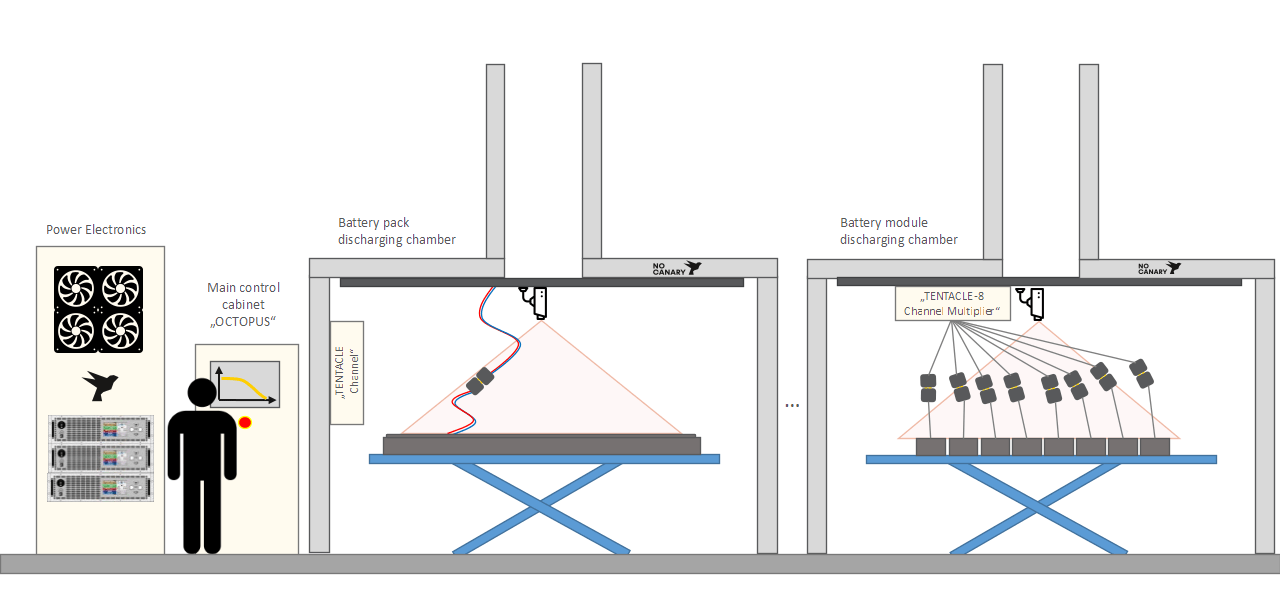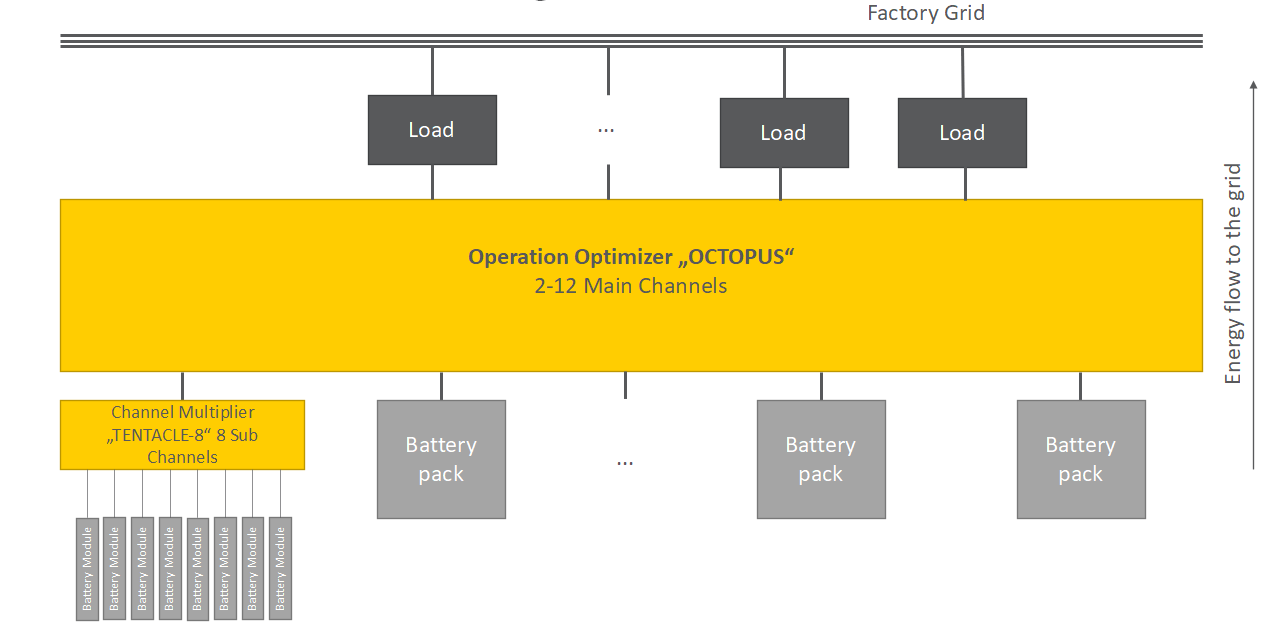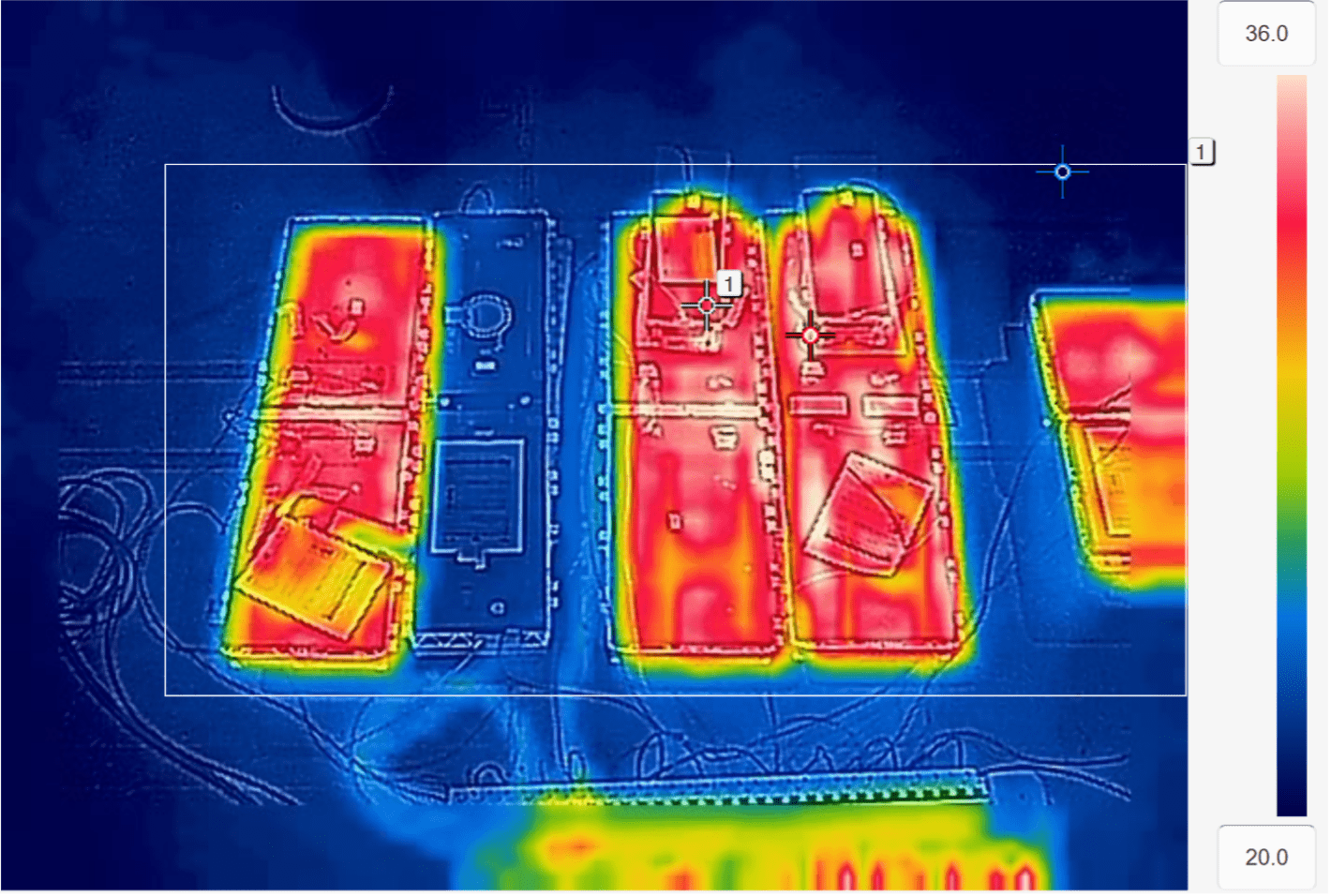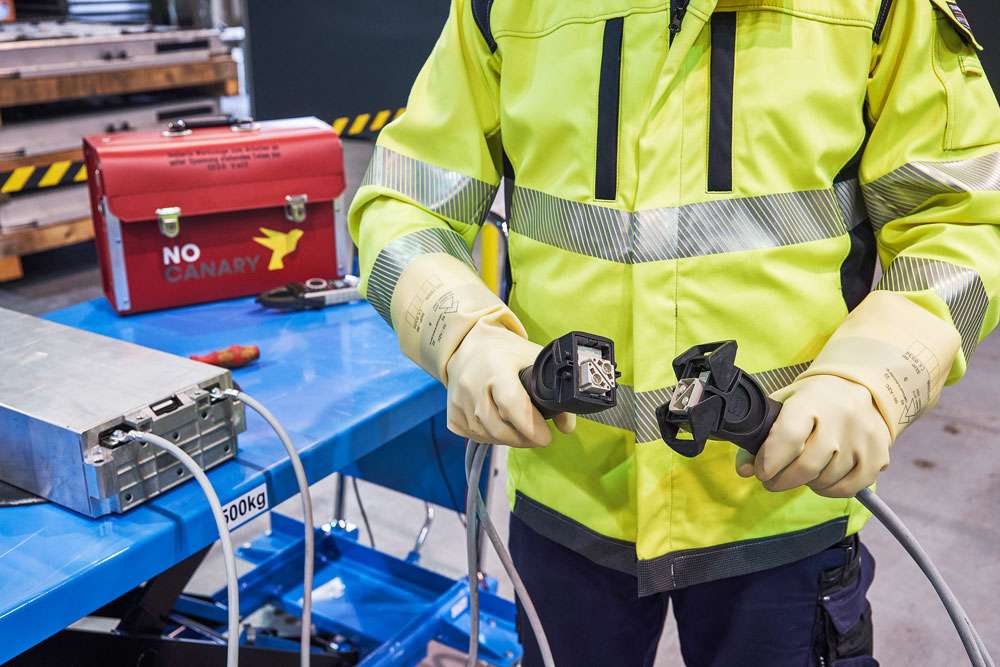Startseite » Recycling Lines » Discharging
Discharging
The discharging of battery cells, battery modules, and battery systems via electrically regenerative discharge systems is the most environmentally friendly way to deactivate lithium-ion batteries in preparation for recycling. The batteries provide the energy for their own recycling. In addition, deep discharge of batteries via safe discharge systems is the most cost-effective way to produce deactivated input material from hazardous large batteries for battery recycling. The OCTOPUS system is the most efficient way to prepare for mechanical recycling, safely and scalably.
High-Performance
The high discharge power and a voltage range of up to 1000V allow for high-performance discharging. Our operating point optimizer continuously optimizes the utilization of the system, ensuring the maximum throughput at all times. With the TENTACLE add-on, each discharge channel can simultaneously operate multiple smaller low-voltage batteries, increasing the throughput for modules.
Plug and Play
Flexibility
Each of the main channels can be converted from a battery pack discharge channel to eight battery module discharge channels in seconds. To do this, a main channel is connected to the channel multiplier via quick connectors. This allows for quick and easy adaptation to changing input currents.
The OCTOPUS System

To secure your disassembly and recycling processes, a safe and fast deep discharge of batteries is necessary. Professionally deep-discharged batteries pose a significantly lower risk throughout the process and allow for better process control in all subsequent steps.
The OCTOPUS system therefore includes:
- Complete battery deep discharge technology
- Control concept for a highly optimized, interference-free discharge
- With monitoring and thermal imaging technology
- With protective chambers and carriers
Process know-how and procedures with the following additional features:
- Regenerative battery deep discharge with optional grid zero reference control
- Comprehensive protection functions: overvoltage, overcurrent, reverse polarity protection, anomaly detection based on discharge curves
- Integrated operating point optimizer for power electronics
- Channel multiplier TENTACLE-8 to increase the channel count for low-voltage batteries
- Discharge protection chambers with smoke extraction and fire detection
- Optimized carriers for battery systems and battery modules
The OCTOPUS system is a solution specifically developed for the deep discharge of lithium-ion batteries. It comes with complete operating software with a user-friendly interface. User safety and system protection are addressed through specific solutions for battery recycling. These include, among others:
- Reverse polarity protection
- Overvoltage protection
- Overcurrent protection
- Anomaly detection based on discharge curves
Unique to the OCTOPUS system are also:
- Operating point optimizer
- Channel multiplier TENTACLE-8
- Automatic short circuit when reaching the 0V threshold
- Custom measurement electronics for recording currents, voltages, and temperatures
- Increased operational safety and component protection through temperature monitoring of all high-performance components in the control cabinets
- Datalogging and OPC-UA Server
- Recipe management and parameter sets for different battery types

Reliability
With years of direct experience in operating a battery deep discharge, we know what matters in a battery deep discharge system. Availability, user-friendliness, and stability are important factors for us.
Safety
An extensive array of sensors allows for continuous and comprehensive measurement of all currents, voltages, and temperatures. Custom-developed electronics provide every relevant current and voltage within the discharge at all times. This not only prevents misuse but also automatically detects and reports anomalies in the discharge curve. Presetting discharge curves based on support points allows you to set the correct currents for each state of charge.
- Reverse polarity protection
- Overvoltage protection
- Overcurrent protection
Each battery is thermally monitored without the need for retrofitting sensors. This allows early detection of thermal anomalies and the discharge to be interrupted.

Economy
Through the automatic monitoring of the discharge process as well as easy and safe handling when connecting the batteries, personnel costs are reduced. In addition, OCTOPUS feeds the recovered energy back into the company’s network as needed, saving a significant amount of energy. In combination with our plant construction for mechanical battery recycling, the process from battery-to-black mass can be carried out largely energy-neutral.
Why does the OCTOPUS discharge recover particularly large amounts of raw materials?
The previous electrical deactivation allows for an ideal, cold separation of materials. In comparison to all thermal processes, no fractions are fused together or chemically reacted here. The lithium is largely transferred to the cathodic coating of the lithium-ion battery through the deep discharge process. This preparation makes it easier to recover lithium-free graphite, and the valuable lithium can be more efficiently recovered from the cathodic active materials at higher recovery rates.
Why is the OCTOPUS discharge particularly environmentally friendly?
By recovering all the energy from the processed batteries with an efficiency of up to 95%, a large portion of the energy needed for further processing of lithium-ion batteries is already available. The batteries can then be recycled more efficiently. The gentle deactivation through deep discharge allows for good separation efficiency in subsequent processes, where large amounts of lithium, graphite, cobalt, nickel, manganese, aluminum, copper, and electrolyte components can be recovered.
Performance Data
Voltage range: 0-1000VDC
Number of channels: 2-12 main channels per system
Discharge current per channel: up to 100A
Power range: 5kW to 432kW
Channel multiplier: 8 sub-channels on one main channel
Fire detection and thermal imaging technology
Stay up-to-date. Be informed about updates: Follow No Canary on LinkedIn https://www.linkedin.com/company/nocanary/
Startseite » Recycling Lines » Discharging
Discharging
Stay tuned Follow No Canary on LinkedIn https://www.linkedin.com/company/nocanary/
